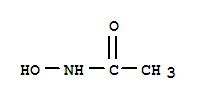Technology Process of Acetohydroxamic acid
There total 87 articles about Acetohydroxamic acid which
guide to synthetic route it.
The literature collected by LookChem mainly comes from the sharing of users and the free literature resources found by Internet computing technology. We keep the original model of the professional version of literature to make it easier and faster for users to retrieve and use. At the same time, we analyze and calculate the most feasible synthesis route with the highest yield for your reference as below:
synthetic route:
- Guidance literature:
-
hydroxylamine hydrochloride;
With
sodium hydroxide;
In
water;
at 20 - 25 ℃;
for 0.15h;
ethyl acetate;
at 30 - 35 ℃;
for 0.25h;
Temperature;
- Guidance literature:
-
With
hydroxyammonium sulfate; sodium ethanolate;
In
ethanol;
at 25 ℃;
for 2h;
Concentration;
- Guidance literature:
-
With
hydrogenchloride; iron(III) chloride; amidase from Pseudomonas aeruginosa strain L10; hydroxylamine; cetyltrimethylammonium bromide;
In
octanol; n-heptane; water;
for 0.5h;
aq. buffer;
Enzymatic reaction;
DOI:10.1016/j.procbio.2011.11.001



 T
T


